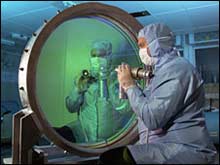British scientists have activated the World's most powerful laser in an experiment to aid in the development of a nuclear fusion reactor. The project involved heating matter to 10 million degrees Celsius, which amounts to 100 times the world's electricity output, on to a spot of about the size of a pin head. The vulcan laser fusion experiment is the first of its kind in the World.
This is the first step leading to the construction of Hiper (High Power laser Energy Research) laser facility which will test the full scale implementation of a laser fusion reactor.
"Hiper is a proposed, very large-scale facility and so we have to check that our understanding is correct," explained Professor Peter Norreys of the Rutherford Appleton Laboratory (RAL) in Oxfordshire where the experiments took place.
Nuclear fusion is looked on as a panacea in a world that demands ever increasing amounts of energy.
The fuel for the process is deuterium and tritium, two heavier forms of hydrogen. Deuterium is commonly found in seawater, whilst tritium can be made from lithium in a so-called "breeder" reactor.
When these isotopes are combined at high temperatures, a small amount of mass is lost and a colossal amount of energy is released.
The process naturally occurs in the core of the Sun where huge gravitational pressure allows this to happen at temperatures of around 10 million Celsius.
At the much lower pressures on Earth, temperatures to produce fusion would need to be much higher - above 100 million Celsius.
Ultra powerful lasers, such as Hiper, have been proposed as one method for reaching these extreme conditions, although many remain sceptical about the technique.
The project has been drawn up to capitalise on another project at the National Ignition Facility (NIF) at the Lawrence Livermore National Laboratory in California.
NIF is expected to demonstrate energy production from laser driven fusion between 2010 and 2012.
If proven, the technology could rival the current favoured technique for initiating fusion which uses superconducting magnets to contain and fuse the hydrogen nuclei.

